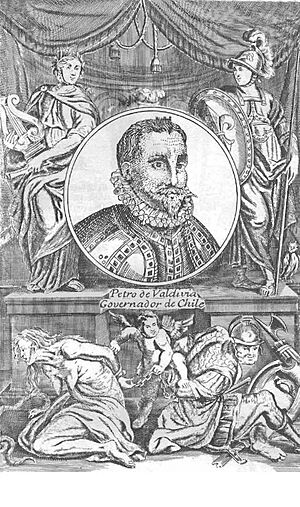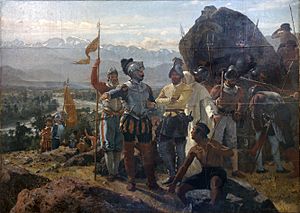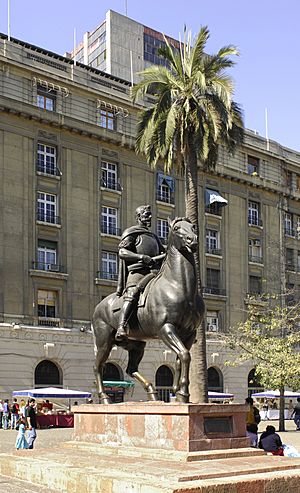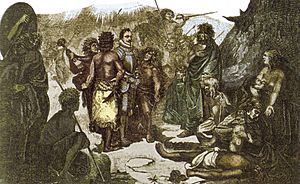Pedro de Valdivia facts for kids
Quick facts for kids
Pedro De Valdivia
|
|
|---|---|
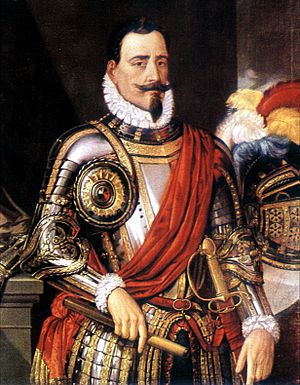
Posthumous portrait by Federico de Madrazo
|
|
| 1st Royal Governor of Chile | |
| In office June 10, 1540 – December 1547 |
|
| Monarch | Charles I of Spain |
| Preceded by | Office established |
| Succeeded by | Francisco de Villagra |
| 3rd Royal Governor of Chile | |
| In office July 20, 1549 – December 25, 1553 |
|
| Monarch | Charles I of Spain |
| Prime Minister | Pedro de la Gasca |
| Preceded by | Francisco de Villagra |
| Succeeded by | Francisco de Villagra |
| 2nd Adelantado of Terra Australis | |
| In office August 2, 1540 – December 25, 1553 |
|
| Monarch | Charles I of Spain |
| Preceded by | Pedro Sancho de la Hoz |
| Succeeded by | Jerónimo de Alderete |
| Personal details | |
| Born | April 17, 1497 Villanueva de la Serena, Vegas Altas, Badajoz, Extremadura, Spain |
| Died | December 25, 1553 (aged 56) Tucapel, Cañete, Chile |
| Spouse | Marina Ortíz de Gaete |
| Military service | |
| Allegiance | |
| Years of service | 1520–1553 |
| Battles/wars | |
Pedro de Valdivia (born April 17, 1497 – died December 25, 1553) was a Spanish conquistador. He became the first royal governor of Chile. He served in the Spanish army in Europe before traveling to South America in 1534. There, he worked as a lieutenant under Francisco Pizarro in Peru.
In 1540, Valdivia led an expedition of 150 Spaniards into Chile. He defeated local warriors and founded the city of Santiago in 1541. He expanded Spanish control south to the Biobío River by 1546. After fighting in Peru, he returned to Chile as governor in 1549. He continued to settle Chile, founding Concepción in 1550. Valdivia was captured and killed during a fight against the Mapuche people. The city of Valdivia in Chile is named after him.
Contents
Early Life and Military Career
Pedro de Valdivia was born in Villanueva de la Serena, Spain, around 1497. His family was not wealthy. In 1520, a civil war called the Revolt of the Comuneros started in Spain. Valdivia joined the army of King Charles I.
He later fought in Flanders in 1521 and in Italy from 1522 to 1527. He took part in the Battle of Pavia in 1525. In 1527, Valdivia was involved in the sack of Rome.
Arrival in the Americas
Valdivia traveled to South America in 1535. He spent a year in what is now Venezuela. In 1537, he moved to Peru.
In Peru, he supported Hernando Pizarro against Diego de Almagro. Valdivia fought in the Battle of Las Salinas in 1538. Almagro was defeated and captured. Valdivia then helped conquer other areas in Peru and Bolivia. For his help, he received a silver mine and became wealthy.
Valdivia had married Marina Ortíz de Gaete in Spain. In Peru, he met Inés de Suárez, a widow. She later joined his expedition to Chile.
Journey to Chile
After Diego de Almagro's expedition to Chile failed in 1536, the lands south of Peru were still unexplored. Valdivia asked Governor Francisco Pizarro for permission to conquer this area. Pizarro agreed, but appointed Valdivia as Lieutenant Governor, not full Governor.
Valdivia had to sell his lands and mine to pay for the trip. It was hard to find soldiers because many thought Chile was a poor land. While Valdivia prepared, Pedro Sánchez de la Hoz arrived from Spain with a royal grant for the same territory. To avoid problems, Pizarro suggested they work together. They signed a partnership agreement on December 28, 1539.
The small group left Cuzco, Peru, in January 1540. They brought seeds for planting, pigs, horses, and nearly a thousand native warriors. Only one woman, Inés de Suárez, Valdivia's companion, was among them. More Spaniards joined along the way, attracted by Valdivia's reputation. About 150 Spaniards joined the expedition in total.
Valdivia decided to avoid the Andes mountains, which had caused problems for Almagro's army. He bravely traveled through the Atacama Desert. On the journey, Sancho de Hoz tried to murder Valdivia to take control. He failed and was pardoned, but had to accept Valdivia as his leader. The local people were not happy about the Spaniards returning. Valdivia made promises and slowly gained their trust. After five months, the group reached the Copiapo valley. Valdivia officially claimed the land for the Spanish king.
They continued south and in December 1540, reached the Mapocho river valley. This is where they decided to build the capital. The valley was large, had many native people, fertile soil, and fresh water. Two hills offered good defense. Valdivia tried to show his good intentions by sending gifts to the local leaders, called caciques.
On February 12, 1541, Valdivia officially founded the city of Santiago de la Nueva Extremadura. It was named after Saint James (Santiago) and Valdivia's home region in Spain. The ceremony took place at the foot of Huelén hill, now known as Santa Lucia hill.
After arriving, Valdivia and his men tried to improve relations with the native people. These relations had been damaged by Almagro's harsh actions. At first, Valdivia was successful. However, this peace did not last long. Valdivia ordered a ship to be built at the mouth of the Aconcagua River. This ship would bring supplies from Peru. Soon, rumors of gold at the Marga Marga mines caused Spanish greed to surface. The Spanish forced the native people into labor to work the mines.
Building the Colony
In 1541, Valdivia learned that Francisco Pizarro had been killed. The city council of Santiago then appointed Valdivia as governor of the territory. This removed Chile from Peruvian control. Valdivia now answered only to the Spanish king, which the Crown accepted. He explored further south and helped the colony grow. He divided land among his followers and assigned native people to work for them. Chile had some minerals, but Valdivia focused more on farming and raising animals. Still, the colony was not very rich. Gold was scarce, and the Mapuche people were strong fighters.
Santiago Attacked
After a period of peace, the native people began to fight back. Valdivia marched against some tribes and defeated them at Cachapoal. While he was away, on September 11, 1541, local people led by Michimalonco attacked Santiago. Valdivia's companion, Inés de Suárez, led the city's defense. The Spaniards fought bravely and pushed the attackers back. Valdivia and his troops returned just in time to help defend the capital.
The entire town was destroyed and burned. Animals were killed, and fields and supplies were ruined. Only a few things survived, like some seeds, two sows, one pig, and a pair of chickens. Valdivia organized his men to guard the crops and protect the city. For the next two years, men were always ready to fight if the native people threatened Spanish rule.
This attack was a major setback for the conquest of Chile. The native resistance grew stronger. Since the ship built at Aconcagua was also destroyed, Valdivia sent his lieutenant, Alonso de Monroy, to Peru in 1542. Monroy went overland with five men to ask for more help. However, Peru was in turmoil, so Monroy could not get much aid. He returned in September 1543 with only seventy horsemen. He also sent a ship with supplies to Aconcagua by sea.
Expanding the Colony
In September 1543, new weapons, clothes, and equipment arrived from Peru on the ship Santiaguillo. With these supplies, Valdivia could rebuild Santiago. He also sent an expedition led by Juan Bohón to explore and settle northern Chile. This group founded La Serena, located between Santiago and the Atacama Desert. Valparaíso was used as a port from the start, but it did not have many people until much later.
In 1544, Valdivia sent a naval expedition. The ships San Pedro and Santiaguillo, commanded by Juan Bautista Pastene, explored the southwestern coast of South America. Valdivia ordered Pastene to reach the Strait of Magellan. Pastene did not reach the strait, but he explored much of the coast. He entered the bay of San Pedro and landed at places now known as Concepción and Valdivia. The city of Valdivia was later named in his honor. After facing severe storms further south, Pastene returned to Valparaíso.

In February 1546, Valdivia himself set out with sixty horsemen and native guides. He crossed the Itata River and reached the Bío-Bío River. He wanted to found another town there. However, Mapuche warriors defended their land at the Battle of Quilacura. Valdivia realized he could not continue with so few men in such hostile territory. He wisely decided to return to Santiago. He had found a good spot for a new city at what is now Penco, which would become the first site of Concepción. Valdivia managed to control the land between Santiago and the Maule River.
Return to Peru
To get more help and confirm his claims, Valdivia returned to Peru in 1547. He left Francisco de Villagra as governor in his place. In Peru, he tried to gather more resources and men. When the Gonzalo Pizarro rebellion began in Peru, the rebels tried to get Valdivia to join them. However, in early 1548, Valdivia joined the royal army of Viceroy Pedro de la Gasca. His military experience was very important in the victory of Xaquixahuana on April 9, 1548.
Some people from Chile were unhappy with Valdivia. They had him put on trial in Lima. He was accused of misusing public money. He was also accused of living openly with Inés de Suárez while married. To be set free and confirmed as Royal Governor, he agreed to separate from Inés. He also agreed to bring his wife, Marina Ortíz de Gaete, to Chile. She arrived after Valdivia's death in 1554. He was also ordered to arrange a marriage for Inés. When he returned to Chile in 1549, he arranged for her to marry one of his captains, Rodrigo de Quiroga. For his services, Valdivia was finally appointed adelantado and confirmed as Governor of Chile. He returned to Chile with his position and reputation much stronger.
Arauco War and Valdivia's Death
Between 1549 and 1553, after returning to Santiago, Valdivia again tried to conquer southern Chile. But he faced strong resistance from the native people. Valdivia fought the Mapuche people beyond the Bio-Bio River in 1550. He defeated them but did not break their will to resist. Their resistance grew stronger when he built settlements in their territory. Despite fierce fighting at the Battle of Penco, he founded Concepción on March 3, 1550. Later, he founded more southern towns like La Imperial, Valdivia, Angol, and Villarrica in 1551 and 1552.
The Uprising of 1553
After a short stay in Santiago, Valdivia returned south in December 1552. To keep the connection open between Concepción and the southern settlements, Valdivia built several forts. He moved against the Mapuche again in 1553 and built a fort at Tucapel. The Mapuche leaders, advised by the chief Colocolo, united their efforts. They chose the famous warrior Caupolicán as their general.
Valdivia had captured an Araucanian youth named Lautaro. Lautaro became Valdivia's groom. But Lautaro secretly remained loyal to his own people. He rejoined them to show Caupolicán how to defeat Valdivia. In late 1553, the Mapuche under Lautaro revolted. They attacked the spread-out Spanish forces in the south. One of the first signs of the rebellion was the attack on the fort at Tucapel. They destroyed the fortress on December 2, 1553. Valdivia was in Concepción when he heard about this. Believing he could easily stop the uprising, he rushed south with only 40 men.
Near the ruins of the fortress, Valdivia gathered the remaining soldiers. He was ambushed before reaching his destination. The Battle of Tucapel was Valdivia's last fight. As each wave of attackers was defeated, Lautaro sent another. Eventually, the entire Spanish group was killed. The famous conquistador was captured alive along with a priest by the Mapuche.
Valdivia's Death
There are different stories about how Valdivia was killed. According to Jerónimo de Vivar, who lived at the time, Caupolicán personally ordered Valdivia's execution. Alonso de Góngora Marmolejo, another writer from that time, says Valdivia offered to leave all Spanish settlements in Mapuche lands and give them many animals. But this offer was refused.
Another writer, Pedro Mariño de Lobera, wrote that Valdivia offered to leave Mapuche lands. But he says Valdivia was killed shortly after by a warrior named Pilmaiquen. Pilmaiquen said Valdivia could not be trusted to keep his word. It is likely that all these stories about his death are not fully accurate. This is because none of his group survived the battle. The only known witnesses were native fighters captured in later battles.
In Literature
Valdivia was an educated man who wrote as well as he fought. In 1552, Valdivia sent Captain Jerónimo de Alderete to the king, Charles I, with a story of his adventures. His twelve letters to the king are still kept in the archives. They are well-written and important for history.
His life and death are told in the epic poem La Araucana by Alonso de Ercilla. He is also a main character in several historical novels. These include Inés y las raíces de la tierra (1964) by María Correa Morande, Ay Mamá Inés - Crónica Testimonial (1993) by Jorge Guzmán, Arauco: A Novel (2013) by John Caviglia, and Inés of My Soul (2006) by Isabel Allende. He also appears in They sure did something for the history of Chile by Alvaro Espinoza.
See also
 In Spanish: Pedro de Valdivia para niños
In Spanish: Pedro de Valdivia para niños
- Jerónimo de Alderete
- Francisco de Villagra
- Francisco de Aguirre
- Inés de Suárez
- Juan Jufré
- Arauco War
- Mapuche people
- Lautaro
- Caupolicán
- Colocolo


